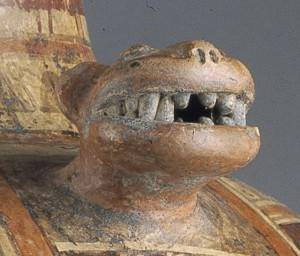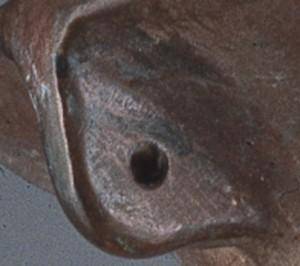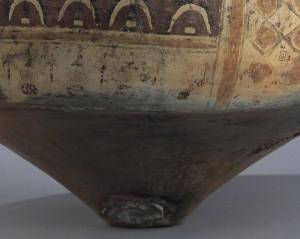Students will learn about the purpose and use of the Inca Arybalo, discover how containers for liquids have changed during the course of history, and design a container for liquids for a special occasion.
Students will be able to:
- describe the artistic characteristics, purpose, and use of the Inca Arybalo;
- explain how containers for liquids have changed throughout history; and
- design a container for liquids using a variety of artistic materials.
Lesson
- Warm-up: Provide the students with a piece of blank paper and a pencil. Ask the students to draw a large number 8 on the paper. Invite the students to transform the number into a creative picture!
- Display the Inca Arybalo and invite students to examine it closely. What do they notice? What colors do they see on the Arybalo? How would they describe its shape? What do the students think the Arybalo was used for? How is it similar and different to other pieces of art they have seen?
- Discuss how this Arybalo resembles ancient Greek ceramics and was probably used to serve chicha, a drink made from corn, during festive, ceremonial occasions during the era of the Inca Empire. Invite students to pay particular attention to the design elements of the vessel, such as the jaguar lug at the base of the neck, the pointed base, and the handles on the sides. See the About the Art sheet for more information.
- Invite the students to conduct a mini-research project and find pictures of containers for liquids throughout history (e.g. amphoras from ancient Greece, water jars from ancient Egypt, punch bowls or water coolers from contemporary society) using the library and internet. For younger students, print off pictures of different types of containers for them to look. Ask the students: What do you notice about the containers? Why do you think the containers are shaped like they are? How are the containers decorated? How have vessels for liquids stayed the same and how have they changed during the course of time? If time is a consideration, you might want to gather this information in advance, divide students into small groups, then have each group explore one kind of vessel and report their findings to the rest of the class.
- Then tell the students that they are going to design a container for liquids for a special occasion. As a class, brainstorm ideas for special occasions that the students might want to design a container for (birthdays, weddings, first day of summer, first time riding a bike, etc.) Invite them to think about the following questions: What would the container look like? How big would it be? When would the container be used? Who would be allowed or encouraged to use it? What kind of beverage would it contain?
- Once the students have developed their ideas, have them draw or paint a picture of what their container for liquids would look like. Be sure to display all the students’ artwork in a prominent place in the classroom!
Materials
- Access to the Internet or library
- Colored markers, colored pencils, or paints and paintbrushes
- Drawing or art paper
- About the Art sheet on Inca Arybalo (found at the end of the lesson plan) or student access to this part of Creativity Resource online
- One color copy of the jug for every four students, or the ability to project the image onto a wall or screen
Standards
- Visual Arts
- Collaboration
- Critical Thinking & Reasoning
- Information Literacy
- Invention
- Self-Direction
Urpu with Insect Design
We don’t know who crafted this jug, but because of its shape, we know that the artist lived during the time of the Inca Empire. Vessels such as these were made in both large and small sizes. The artist formed the jug out of clay, smoothed the surface, and then decorated it with colored slips that were made up of a mixture of clay, water, and mineral pigments. Finally, the surface of the vessel was burnished or polished before firing.
Ceramics made by craftsmen in the workshops of Cuzco, the Inca capital, were highly prized as tangible evidence of imperial prestige. Local imitations were produced throughout the vast territory conquered by the Inca, which extended from Ecuador in the north to Chile in the south. Numerous ethnic groups and independent political entities were not only conquered but also effectively integrated into a centrally administered political and economic system.
Vessels of this shape were used to hold liquids, especially chicha, a kind of beer made from corn. Very large vessels like this one would probably have been used on festive, ceremonial occasions. In the Inca Empire, commoners paid tribute to their local lords, religious authorities, and imperial administrators in the form of labor and military service. These authorities reciprocated with food, clothing, and other necessities. Most importantly, leaders held feasts for their tributaries, providing copious amounts of chicha. Serving this beer from an elaborately decorated jar such as this emphasized the wealth and generosity of the Inca state. Inca vessels of this shape are called aryballos because of their resemblance to similarly shaped ancient Greek ceramics.
Details

Painted Decorations
The painted decorations on this vessel are particularly elaborate. Red and black flamingos form lines around the neck. The front of the vessel is divided into three zones: a vertical central panel with a diaper pattern (an all-over diamond-shaped pattern) that is flanked by two horizontally subdivided sections filled with insects and flowers.

The Lug
The lug, found on the vessel’s shoulder at the base of the neck, is shaped like a jaguar head with a toothy mouth.

Ingenious Design
The handles and lug, along with a strap, were used to transport the jug. The strap was looped through one handle, up over the top of the lug, and then down through the other handle. The person carrying the jug used his back for support and tied the two free ends of the strap around his waist.

Holes at the Rim
There are two small holes under the rim of the vessel that would have been used to secure a lid (now missing).

Pointed Base
The pointed base was intended to be set in a depression in a dirt floor.
Funding for object education resources provided by a grant from the Morgridge Family Foundation. Additional funding provided by the William Randolph Hearst Endowment for Education Programs, and Xcel Energy Foundation. We thank our colleagues at the University of Denver Morgridge College of Education.
The images on this page are intended for classroom use only and may not be reproduced for other reasons without the permission of the Denver Art Museum. This object may not currently be on display at the museum.







